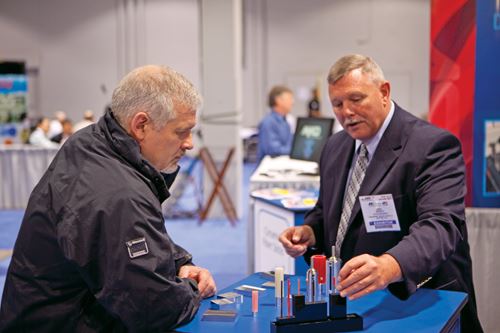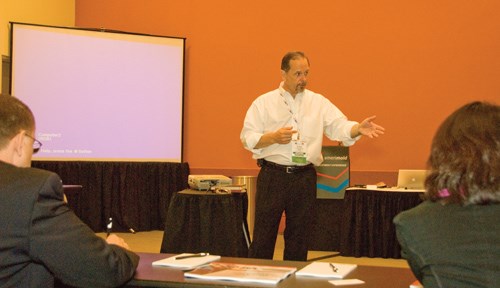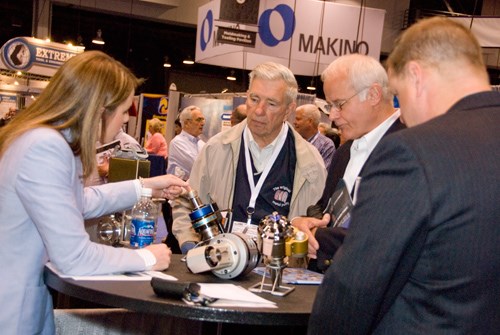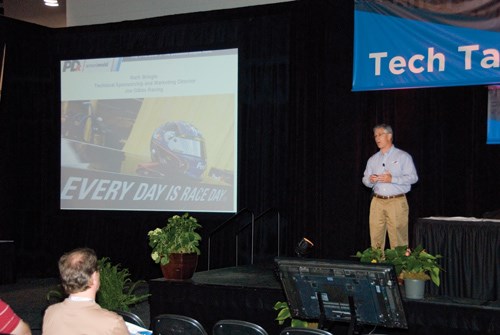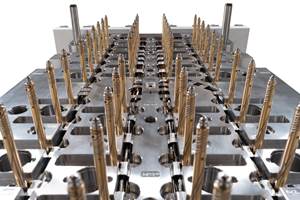Collaboration, Connection and Cooperation
This inaugural event ties together the entire product development life cycle—from concept to completion—and opens mold manufacturers’ eyes to the importance of value-added services.
Held last month in Cincinnati, OH, PDx/amerimold—the first event of its kind—bridged the gap between industrial designers, the manufacturing engineering community and original equipment manufacturers. Conferences, plant tours and exhibits paved the way for the sharing of ideas, networking and industry education that helped attendees establish, renew and solidify partnerships.
Attendees left the event armed with knowledge on how to further slash leadtimes while offering more value-added products and services to their customers. Connecting product design and development with manufacturing on the show floor opened the eyes of attendees to new possibilities within their current operations and offerings. For example, DMLS technology that was highlighted on the PDx side of the show is now being used in mold manufacturing and will someday likely become mainstream. Micro finishing technology also has practical application and value within moldmaking. Having these emerging technologies cross-marketed to the mold manufacturing and OEM communities is a great step forward to seeing these technologies advance. The event also showcased how technology and service suppliers are continuing to collaborate in an effort to offer complete solutions to mold manufacturers—not just products—whether it be cutting tool and software providers, laser sintering providers and finishing technology manufacturers, and components suppliers with mold repair providers.
The mood on the show floor was one of cautious optimism. Most attendees and exhibitors noted business is improving, albeit not as fast as they would like. Many companies also seemed focused on niche business, realizing that to be successful special offerings are a must. Placing demands like these on our industry is advantageous for those willing to step up to the challenge. MoldMaking Technology Economics Editor Bill Wood believes that the industry is clearly in recovery after hitting “rock bottom” last year. To that end, mold manufacturers are no longer satisfied with doing business the “old” way; instead, they are looking to form strategic alliances with vendors and other companies so they can compete in this new economy.
There is no substitute for live attendance at a trade show. There are proven strategies to learn about; cutting-edge technology to see, hear and touch; new customers to meet and fresh business contacts to develop. Face time is invaluable. One exhibitor with an international presence expressed an interest in partnering with a U.S. moldmaker if the need arose for tools to be managed by a U.S. firm but built overseas. Several OEMs were looking to partner with mold manufacturers who could do developmental mold and tooling at a very high-level with a need for pre-production and fast delivery. At the same time, these OEMs desired a mold manufacturer who would work with them through the entire process and share lessons learned.
All-in-all PDx/amerimold promoted industry connection—to technologies, knowledge, companies, people, ideas and new business opportunities—all leading to innovation.
PDx/amerimold Technical Programming
“What can I do now and how do I apply it?” questions were answered over the three days of conference programming. From workshops to tours to seminars, attendees saw strength in the technical data and direct applications presented as well as the up close-and-personal discussions that were held specific to their industries and needs.
Seminars: Technical sessions on CAD, CAM, aluminum, mold diagnostics, mold maintenance, business developments and best practices, sustainable product development, 3-D printing, laser sintering and project management drove discovery, discussion and debate.
Workshops: An Additive Manufacturing workshop taught attendees how to take advantage of additive manufacturing technologies to increase business efficiencies, competitiveness, and product quality, while our Building a Globalization Strategy workshop spelled out how to build a globalization strategy that will work for your business no matter what size it is.
Tours: Makino hosted process presentations on automation, hard milling and micro mold machining alongside live machining demos at its Technical Center; while, Morris Technologies/MicroTek/Rapid Quality Manufacturing allowed attendees to tour the facility and discuss the additive manufacturing technologies under one roof—large-format and high-resolution SLA to DMLS.
Tech Talk Theater Presentations
Keynotes tying innovation, design and manufacturing together through Eureka! Ranch, Joe Gibbs Racing and Whirlpool as well as exhibitor presentations occupied the show floor theater.
Doug Hall, founder of both the USA National Innovation Marketplace (NIM) and Eureka! Ranch, gave the opening keynote address—speaking about innovation and how to create, communicate and commercialize meaningfully unique ideas. He urged the audience to keep their minds open to new thoughts and ideas as well as embrace technologies like kaizen to stimulate ideas into action.
Attendees were treated to some exciting NASCAR footage by Mark Bringle, technical sponsor manager of Joe Gibbs Racing. He then provided an overview of the rapid product development and manufacturing process that was used to produce and refine the cars and engines to give them the winning edge required to be successful in NASCAR—tying in 3-D printing of concept parts and the subsequent reduction in development times from traditional methods and what that could mean to the success of the team.
The relationship between engineers and designers (stylists) and the perceived stereotypes that can be detrimental to the development/manufacturing process and eventual product success was the subject of a presentation by Richard Gresens, Principal Designer—Program Strategy, Global Consumer Design for Whirlpool Corp. Using these principles, he walked the audience through several examples in his career where theses principles have helped lead to successful programs.
2010 Leadtime Leaders Honored
The MoldMaking Technology eighth annual Leadtime Leaders were honored at an Awards Ceremony in the Tech Talk Theater.
After their awards were presented, the honorees gave a brief presentation on their companies, highlighting their business and technological strategies that resulted in their Awards. This was followed by a Q&A session that allowed attendees to ask specific questions on equipment choices, technology choices and business issues.
When asked about the most significant steps each Leadtime Leader made to reduce leadtimes and how work is scheduled throughout the organizations, answers included: through scheduling processes like computer and visual scheduling, adding automation, and putting the right people in place who are willing to go the extra mile and learn how to properly use equipment and run it to its fullest potential. Customized shop floor management software also is used, with one person dedicated to the successful implementation of the program at one company. Another winner has implemented web meeting software for working through problem part designs and reviewing mold designs with customers.
The honorees also were in agreement about how to handle customers who pay late, with advice ranging from establishing terms upfront before purchase orders are received, offering strict terms, and discouraging one-way relationships. Each Leadtime Leader noted that they were fortunate to have good customers and invaluable relationships.
Finally, CS Tool explained how belonging to a coalition—The Whitehall Township Tooling Coalition—has allowed the company to expand its resources with the ability to jointly market its capabilities along with other coalition members, while being able to use the available resources of manpower and equipment from the eight different shops who belong. Just recently CS Tool designed and constructed two molds for one of its member shops with toolmakers borrowed from another member shop.
Related Content
MMT Chats: 5 in 5 with Best Tool and Engineering
MoldMaking Technology Editorial Director Christina Fuges reveals 5 best practices for improving efficiencies within shops...in 5 minutes. Our guest is Joe Cherluck, President of Best Tool and Engineering in Clinton Township, Michigan.
Read MoreHow to Solve Hot Runner Challenges When Molding with Bioresins
A review of the considerations and adaptations required to design hot runners and implement highly productive injection molding operations.
Read MoreMaking Mentoring Work | MMT Chat Part 2
Three of the TK Mold and Engineering team in Romeo, Michigan join me for Part 2 of this MMT Chat on mentorship by sharing how the AMBA’s Meet a Mentor Program works, lessons learned (and applied) and the way your shop can join this effort.
Read MoreConfronting the Mold Design Talent Drought
Recently, I reposted on LinkedIn the results of an informal survey we conducted, which revealed a shortage of skilled mold designers. It quickly gained a lot of traction. Given the response, I thought I'd summarize the feedback and keep the conversation going.
Read MoreRead Next
Are You a Moldmaker Considering 3D Printing? Consider the 3D Printing Workshop at NPE2024
Presentations will cover 3D printing for mold tooling, material innovation, product development, bridge production and full-scale, high-volume additive manufacturing.
Read MoreHow to Use Strategic Planning Tools, Data to Manage the Human Side of Business
Q&A with Marion Wells, MMT EAB member and founder of Human Asset Management.
Read MoreReasons to Use Fiber Lasers for Mold Cleaning
Fiber lasers offer a simplicity, speed, control and portability, minimizing mold cleaning risks.
Read More
